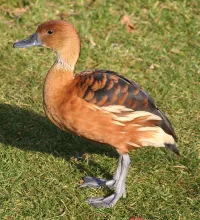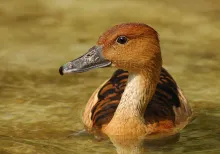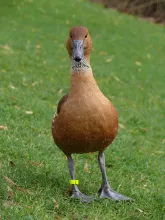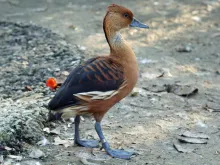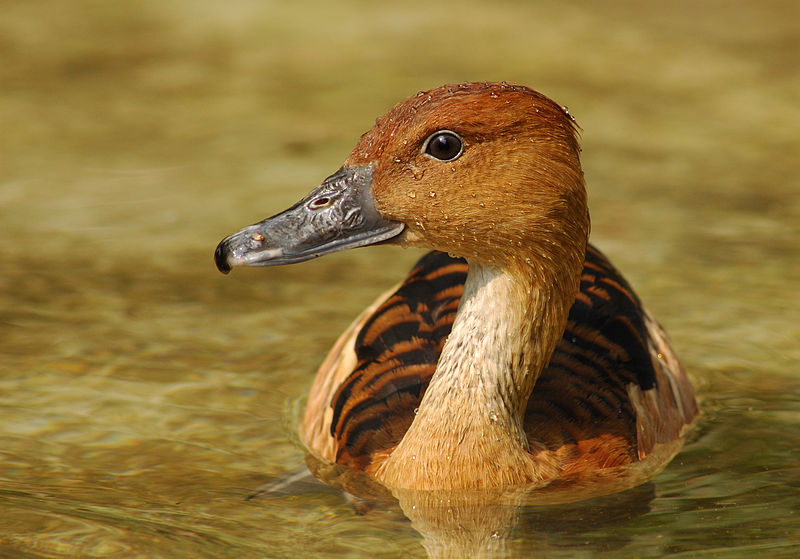
Fulvous Whistling duck (Dendrocygna bicolor)
Species name
- Dutch name:
- Gele fluiteend
- English name:
- Fulvous Whistling duck
- German name:
- Gelbbrust Pfeifgans
- French name:
- Dendrocygne fauve
- Scientific name:
- Dendrocygna bicolor
Scientific classification
- Order:
- Anseriformes
- Family:
- Anatidae
- Onderfamilie:
- Dendrocygninae
- Genus:
- Dendrocygna
Description
- Description:
Male:
Have a Rufous-brown crown and upper nape, which becomes blackish down the center of the hindneck. The sides of the head, neck, chest and belly are a rich Rufous-buff, with the sides of the neck paler, almost whitish, with fine dark striations. The back is dark brown with chestnut feather fringes, and the rump is white. Ivory-edged side and flank feathers form a striking border between the sides and back. A distinctive white "V" separates the brownish-black tail from the dark-colored back. The bill, legs and feet are blue-gray and the iris is dark brown.Female:
As male but slightly smaller and dullerJuvenile:
Duller then adults, with darker edgings to feathers on upper-parts, reduced tawny edgings on upperwing-converts and brown margins to whitish uppertail –converts.
- Behaviour:
Strong, probably permanent pair-bonds.
Standard Measurements
- Body Length (cm):
- The male (drake) of the Fulvous Whistling duck measures approximately 45-55 centimeters. The female measures approximately 45-53 centimeters.
- Body Weight (grams):
- The male will weight about 621-755 gram. The female will weight about 631-739 gram.
The weight is notoriously variable and can only be used as indication!
- Note:
Whistling-ducks generally do well, either in pens or in a park with access to extensive water area and good natural cover. They are gregarious outside the breeding season, and groups may bully smaller duck species, so should be kept in large areas, in which other birds have room to escape. Most need shelter in severe weather and a well-sheltered pen with frost-free night quarters for winter is suggested, or plenty of ground cover and/or straw to stand on, as they are susceptible to frostbite. They may be kept fully-flighted in aviaries, and have also been kept full-winged in open pens, tending not to wander. Perches should be provided at an appropriate height for pinioned or wing-clipped birds. Commercial pellets and grain are suitable for feeding.
Elevated nest boxes are appreciated by most species, although pinioned birds will use ground-level boxes; boxes may be placed over water or land. Eggs may be incubated by bantams and ducklings may be bantam-reared. Many species have been successfully parent-reared in captivity. Pairs kept isolated and fully flighted in a covered pen, with high-hung nest boxes "seldom fail to rear broods". Whistling-duck species may hybridise with one another and therefore should be kept in separate enclosures, and hybridisation has also occasionally been reported with Rosy-billed pochard (Netta peposaca).
Fulvous whistling-ducks are fairly hardy, but a frost-free area is required for winter - they may need indoor accommodation in severe/frosty weather. They are easy to keep, usually peaceable (some individuals may be fairly aggressive), lively and attractive in mixed collections; they are frequently kept in small groups, therefore being good for display purposes. These ducks are hardy, peaceable and lively. Sizeable ponds are preferred, with a depth of 60-80cm or greater to allow diving; an area for seclusion and opportunities for perching should also be provided. They may be fed wheat and standard pellets, together with green food such as lettuce, duckweed, grass, and bread.
This species is easy to breed. These ducks nest in ground vegetation; they also use ground-level or raised nest boxes or a hollow log screened with vegetation. Egg-laying may begin in April to June. Downies require warmth and care initially, with warm water for bathing. They initially require food in water for filter-feeding, will take moist crumbly food later but will take each beakful to water. These ducklings may be best parent-reared, but an incubator or broody may also be used.
May hybridise with Plumed whistling duck (Dendrocygna eytoni), Lesser whistling duck (Dendrocygna javanica), White-faced whistling duck (Dendrocygna viduata).
- Breeding:
- The female Fulvous Whistling duck usually lays from 6-16 cream to buff-white eggs and incubates them for 28-30 days.
- Artificial incubating:
The ideal relative humidity for incubating most waterfowl eggs is 55% (ground nesters) and 40% (cavity nesters). The temperature is usually 37.4°C. Set ventilation as recommended by the incubator manufacturer. Eggs must be turned, either automatically or by hand, a minimum of 4 times a day. As the duckling develops there is a loss of water from the egg and the air sac gets bigger. In normal development of an egg with a 28-30 days incubation, the air sac occupies about a third of it three days earlier. Cleanliness is vital and ideally eggs should be moved to a separate hatcher at this point, where the humidity should be increased to 65% and even higher once they have pipped internally.
- Bird banding:
- Recommended closed leg band ring size for the Fulvous Whistling duck is 12 mm.The leg band ring can only be applied on a young whistling duck at around 12-14 days old.
- It doesn't matter what leg that you band, but it's good to have a consistent system. Suggested: Left leg = Female, Right leg = Male
- Maintenance food:
-


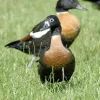


Floating full food for all sea ducks, green ducks, eider ducks and geese, especially in the moulting and breeding phase ideally suited. Packed with wholesome raw materials, natural vitamins and trace elements, this performance food with a protein content of 30% forms the basis for lifelong vitality.
- Regulation:
- Europese soort
- Regulation:
Het is niet verboden om deze vogels te houden die van nature in Nederland voorkomen, op voorwaarde dat deze vogels in gevangenschap zijn geboren; nakweek dus. Deze vogels zijn voorzien van een gesloten pootring. Het is wel verboden om deze vogels te houden die in het wild gevangen zijn. Alleen bepaalde instanties, zoals vogelasiels en vogelhospitalen, zijn bevoegd om jonge en gewonde wilde vogels te houden. Deze bescherming van vogels wordt vormgegeven door schadelijke handelingen te verbieden zoals:het doden, verwonden, vangen, bemachtigen en met het oog daarop opsporen van vogels (art. 9 Flora- en faunawet); het opzettelijk verontrusten van vogels (art. 10 Flora- en faunawet);het beschadigen, vernielen, uithalen, wegnemen en verstoren van nesten, holen of andere voortplantings- of vaste rust- of verblijfplaatsen van vogels (art. 11 Flora- en faunawet);en het zoeken, rapen, uit het nest nemen, beschadigen of vernielen van eieren van vogels (art. 12 Flora- en faunawet).
